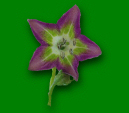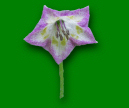ANATOMY OF CHILI, AND ITS FLOWER:
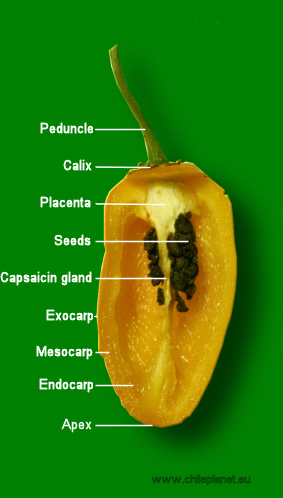
ANATOMICAL PARTS:
PEDUNCLE:The peduncle is, in Botany, a little more or less long branch to which end is the flower.
CALYX:Calyx or Crown is the structural base of the flower. It is generally green in color and its vertices are called sepals. In the case of chili is a "persistent calyx" as it preserves with fruit.
SEEDS: Contain a very low amount of water but rich in lecithin. Contrary to popular belief, the seeds do not contain capsaicin, although since they are accanti to capsaiciniche glands, can absorb a little.
PLACENTA: Organ responsible for metabolic exchanges between fruit and seed. Depending on the variety of Chili can be of different colors: white, yellow or reddish hue.
CAPSAICIN GLANDS: Capsaicin glands are situated between the placenta and the endocarp and are the true sources of hotness. Produce the capsaicin.
ENDOCARP: It is the inside of the fruit, i.e. one that encloses the placenta and seeds.
MESOCARP: Intermediate between the Endocarp and The Exocarp. It is the flesh of the fruit that usually contains most of the water content and provides structural support.
EXOCARP: It is the outer protective layer of a fruit commonly called Peel.
APEX: It is the terminal portion of the fruit, the tip. Depending on the variety can be more or less rounded.
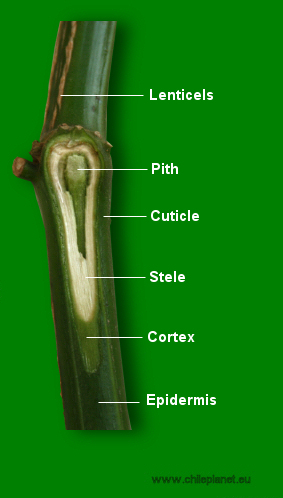
THE CAPSICUM STEM STRUCTURE:
The chilli plant is part of the class of Dicotyledons as the structure of its stem is organized in concentric layers. Starting from the outside are: the cuticle, the epidermis, the cortex, the central cylinder and the medulla. The cuticle is a thin impregnated layer of wax. The epidermis is a set of live cells lining the entire trunk and branches. The cuticle and epidermis together have the function of external protection, controlling the water loss by evaporation. The cortex, in a green stem as in this case, is formed by parenchymatous cells lives with internal protection function to the central cylinder. In the central cylinder, are arranged conductive vessels. The xylem vessels are oriented towards the interior of the stem and are used to transport crude sap (water and minerals), while those of the phloem are oriented outwards and are intended for the transport of sap drawn from the leaves (sugars and organic substances) to other tissues of the plant. The marrow is located inside the central cylinder, where it usually presents in the form of spongy tissue for the presence of large intercellular spaces. The spinal generally has the function of containing reserve substances.
ANATOMY OF CHILLI FLOWER:
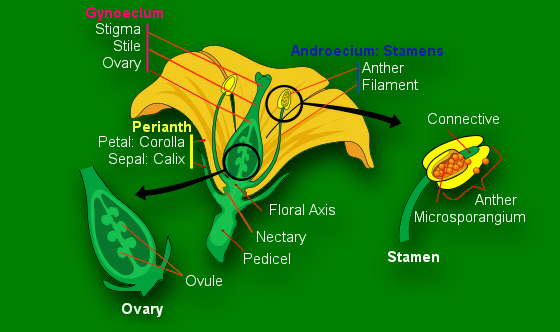
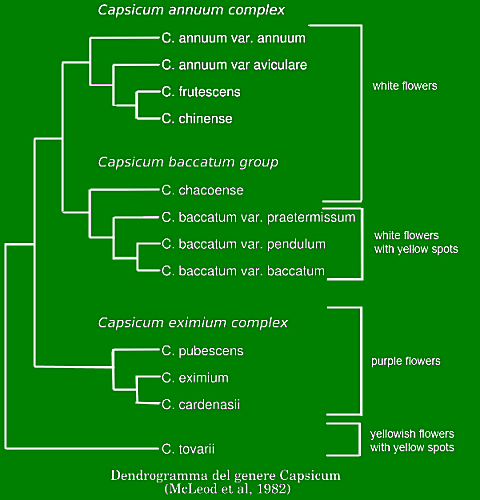
Except for some wild species, the plant of chili is a self-pollinating plant (self-fertile). The self-pollinated occurs when the pollen goes directly from the anther of the flower to the stigma of the same flower. The average life of a flower after the opening is 2-3 days, then attach and become fruit or dries up and falls off. Flower drop is normal, especially with the high summer temperatures which may affect fruit set. An optimal temperature would be: 25 ° C daytime and night of 18 ° C. However, not all plants are the same, in general, the C. annuum better withstand the heat and attach more easily than C. chinense.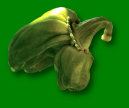 For most varieties, from fruit to ripe fruit, serving an average of 3-4 weeks. Some varieties, such as the Aji Amarillo, (C. baccatum), on the other hand can take up to 10 weeks from fruit to ripe fruit.
For most varieties, from fruit to ripe fruit, serving an average of 3-4 weeks. Some varieties, such as the Aji Amarillo, (C. baccatum), on the other hand can take up to 10 weeks from fruit to ripe fruit.
 Sometimes it is possible that a flower is born double or even triple. For some species, such as C. rhomboideum, the double flowers are quite frequent. If both ovaries are fertilized definitely generate double fruits combined in various ways. The genus Capsicum has a number of species, each with different flowers with features that can vary the size, shape and even color.
Sometimes it is possible that a flower is born double or even triple. For some species, such as C. rhomboideum, the double flowers are quite frequent. If both ovaries are fertilized definitely generate double fruits combined in various ways. The genus Capsicum has a number of species, each with different flowers with features that can vary the size, shape and even color.
THE POLLINATION:
During the process of pollination, pollen enters and passes through the pistil to reach the ovary. Pollen grains subsequently fertilize the eggs which will become later in the seeds contained in the fruit. The next evolution will be characterized by a multitude of events. During this process we have to consider that probably the ovary has been achieved by different types of pollen. When it comes to foreign pollen to the family Solanaceae, the eggs will not be fertilization, but otherwise... well, anything can happen. For example, let’s hypothesis that a bee (or whatever insect pollinator) has visited before other chili flowers, this insect is sure to be drenched by different types of pollen and during our visit to the flower, the inevitable friction with the pistil will enter different types of pollen grains. Come into play now a real cascade of events. If one of the pollen grains, one was of the same species and the same variety, the fertilized egg will become a seed that will play exactly the original features. If the second pollen grain was of the same species but of different varieties, the seed will produce an intersection with intermediate characteristics in the future plant. If the third pollen grain was an other species, the third seed could produce a fertile hybrid with intermediate characteristics, but in case of incompatibility between species, the seed will be sterile. All this... within the same chili pepper.
THE TRICHOMES:
 The trichomes are "hairs" unicellular or multicellular present with greater or lesser density on both pages of the leaf, or on the whole surface of the plant according to the species and sometimes to the variety. Many wild species and varieties as well as the Capsicum pubescens, from Latin fact "hairy", are an example. The functions of trichomes can be multiple, as a defense against attack by insect pests or herbivores, increased resistance in areas subject to cold temperatures or a better collection of water in certain tropical areas where most of the moisture available comes from droplets of the mist. In windy areas, can interrupt the air flow reducing transpiration. A high density of trichomes can reflect sunlight, protecting the most delicate fabrics in very hot and dry habitat. The type, presence and absence, and the position of the trichomes are important diagnostic characters for the identification of plants and taxonomy. Thanks to the study of trichomes by botany Argentine Gloria Estela Barboza, it was possible to detect and classify two new species of wild Capsicum: Capsicum longidentatum and Capsicum caatingae thus bringing about 35 known species.
The trichomes are "hairs" unicellular or multicellular present with greater or lesser density on both pages of the leaf, or on the whole surface of the plant according to the species and sometimes to the variety. Many wild species and varieties as well as the Capsicum pubescens, from Latin fact "hairy", are an example. The functions of trichomes can be multiple, as a defense against attack by insect pests or herbivores, increased resistance in areas subject to cold temperatures or a better collection of water in certain tropical areas where most of the moisture available comes from droplets of the mist. In windy areas, can interrupt the air flow reducing transpiration. A high density of trichomes can reflect sunlight, protecting the most delicate fabrics in very hot and dry habitat. The type, presence and absence, and the position of the trichomes are important diagnostic characters for the identification of plants and taxonomy. Thanks to the study of trichomes by botany Argentine Gloria Estela Barboza, it was possible to detect and classify two new species of wild Capsicum: Capsicum longidentatum and Capsicum caatingae thus bringing about 35 known species.
THE CHROMOSOMES:
The chromosomes are structural units in which the DNA associated with specific proteins, is organized into cells. Chromosomes contain the genetic information (genome) that will transmit to new individuals in cell divisions (meiosis and mitosis). Generally the genus Capsicum has 24 chromosomes, but there are some wild species to 26 chromosomes. The species in 26 chromosomes are:
Capsicum campylopodium Sendtn.
Capsicum cornutum (Hiern) Hunz.
Capsicum dusenii Bitter.
Capsicum friburgense Bianchetti & Barboza.
Capsicum hunzikerianum Barboza & Bianchetti.
Capsicum lanceolatum (Greenm.) Morton e Stanley.
Capsicum mirabile Mart.
Capsicum pereirae Barboza & Bianchetti.
Capsicum recurvatum Witas.
Capsicum rhomboideum.
Capsicum schottianum Sendtn.
Capsicum sp.6 "Piquete".
Capsicum sp.9 "Caraça" .
Capsicum villosum Sendtn.
Flowers Photos are property of John Fiedler kindly provided to Chileplanet.eu.







